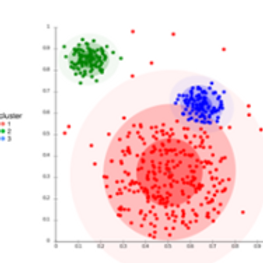
Clustering
Clustering is a machine learning technique used for grouping similar data points or objects together based on certain features or characteristics. The goal of clustering is to partition a dataset into subsets, or clusters, such that data points within the same cluster are more similar to each other than to those in other clusters. Clustering is an unsupervised learning method, meaning that it doesn't rely on labeled data; instead, it identifies patterns or structures within the data on its own.
Applications of Clustering
Customer Segmentation:
-
Clustering is used to group customers with similar purchasing behavior, demographics, or preferences for targeted marketing strategies.
Image Segmentation:
-
In computer vision, clustering can be applied to group pixels with similar characteristics, aiding in image segmentation.
Document Clustering:
-
Grouping similar documents together based on content or topics for information retrieval and organization.
Anomaly Detection:
-
Clustering can be used to identify clusters of normal behavior, helping to detect anomalies or outliers in datasets.
Biology and Genomics:
-
Clustering is used to group genes with similar expression patterns or biological samples with similar characteristics.
Search Engine Result Grouping:
-
Clustering can be applied to group similar search results, making it easier for users to find relevant information.
Social Network Analysis:
-
Identifying communities or groups of users with similar interests or connections in social networks.
Fraud Detection:
-
Clustering can be employed to identify patterns of fraudulent behavior based on common characteristics among fraudulent transactions.
Benefits of Clustering:
Pattern Discovery:
-
Clustering helps in identifying patterns, relationships, or structures within data that might not be immediately apparent.
Data Compression:
-
Clustering can be used to represent a large dataset with a smaller number of cluster centroids, reducing the dimensionality of the data.
Decision Support:
-
Clustering can provide insights for decision-making by revealing natural groupings within datasets.
Efficient Data Exploration:
-
Facilitates the exploration of large datasets by grouping similar data points together.
Key Concepts of Clustering
Similarity or Distance Metric:
-
Clustering algorithms use a similarity or distance metric to measure how close or similar data points are to each other. Common metrics include Euclidean distance, Manhattan distance, or other similarity measures.
Centroid or Representative Point:
-
Many clustering algorithms define a centroid or representative point for each cluster. The centroid is the center of the cluster and is often used to represent the cluster as a whole.
Cluster Assignment:
-
Each data point is assigned to a cluster based on its similarity to other points in that cluster. The assignment is typically determined by minimizing the distance between data points and the centroid of their assigned cluster.
Common Clustering Algorithms:
K-Means:
-
A popular and widely used clustering algorithm that partitions data into k clusters, where k is a predefined number.
Hierarchical Clustering:
-
Builds a hierarchy of clusters by recursively merging or splitting clusters based on the similarity between data points.
DBSCAN (Density-Based Spatial Clustering of Applications with Noise):
-
Forms clusters based on the density of data points, identifying areas with higher point density as clusters.
Agglomerative Clustering:
-
A bottom-up approach where individual data points are initially treated as separate clusters, and then clusters are successively merged based on similarity.
Gaussian Mixture Models (GMM):
-
Assumes that the data is generated from a mixture of several Gaussian distributions and aims to fit these distributions to the data.
Summary
Clustering is a versatile technique used in various domains where grouping or categorization of data points is beneficial for analysis, understanding, and decision-making.
